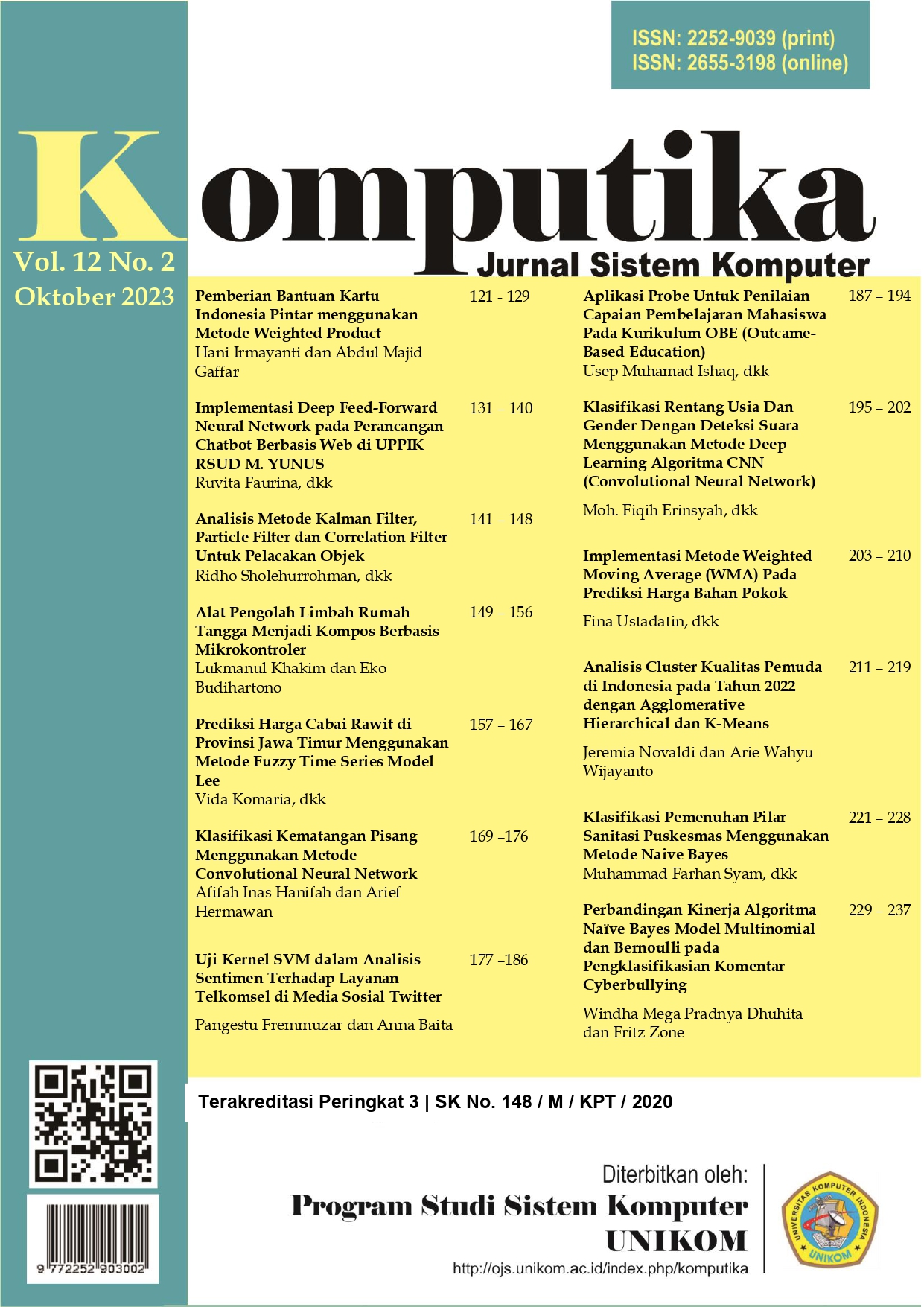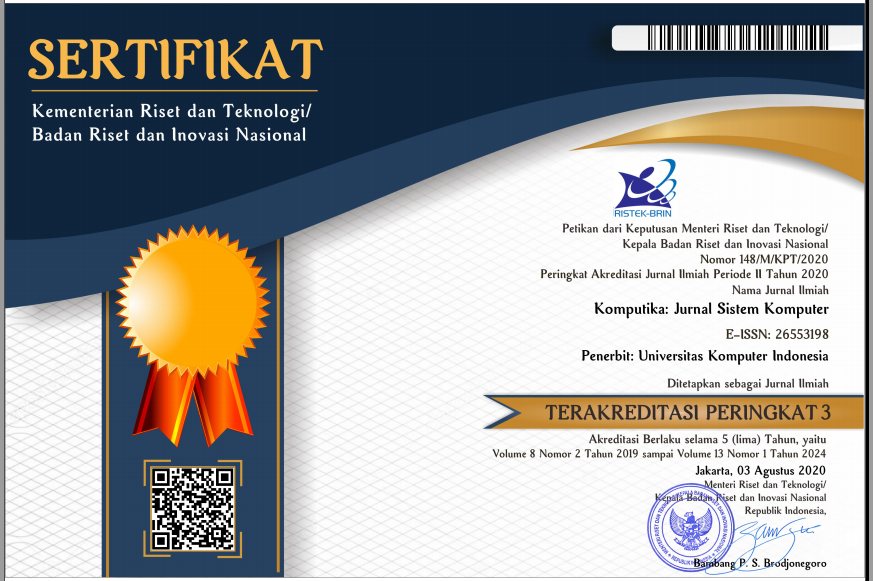Uji Kernel SVM dalam Analisis Sentimen Terhadap Layanan Telkomsel di Media Sosial Twitter
DOI:
https://doi.org/10.34010/komputika.v12i2.9460Abstract
Telkomsel is an internet service provider in Indonesia which was launched in 1995. As an internet
service provider with the most users, Telkomsel has become the center of attention of internet users in Indonesia. This
invites user opinions and perspectives on Telkomsel, which is commonly referred to as sentiment. One of the media
commonly used to express an opinion and point of view is Twitter. Twitter is a social media platform that is often a
place for sharing and spreading the news, and discussing ideas, and opinions of Twitter users. In this study, the algorithm used
is the Support Vector Machine. In the Support Vector Machine, there is a kernel trick that will be used to determine
kernel performance and analyze sentiment. The sentiments analyzed amounted to 537 tweets collected by scraping.
The collected tweets will go through the preprocessing stage, namely cleaning, case folding, tokenizing, normalization,
stemming, stopword removal, and detokenizing. A sentiment is classified into 2 labels, namely positive and negative.
Based on the test results, the sigmoid kernel has the best performance with an accuracy value of 0.950, a precision of
0.945, a recall of 0.860, an f1-score of 0.896, and sentiment tend toward negative.
References
A. G. Gani, “Sejarah dan Perkembangan Internet di Indonesia,” Jurnal Mitra Manajemen, vol. 5, no. 2, 2020.
T. S. Siregar and A. Lubis, “Faktor – Faktor Yang Mempengaruhi Kepuasan Pelanggan Kartu Telkomsel Di Kecamatan Medan Baru,” Jurnal Ilmiah Manajemen dan Bisnis (JIMBI), vol. 3, no. 1, pp. 92–105, May 2022, doi: 10.31289/jimbi.v3i1.988.
S. Nurajizah, N. A. Ambarwati, and S. Muryani, “Sistem Pendukung Keputusan Pemilihan Internet Service Provider Terbaik Dengan Metode Analytical Hierarchy Process,” JURTEKSI (Jurnal Teknologi dan Sistem Informasi), vol. 6, no. 3, pp. 231–238, Aug. 2020, doi: 10.33330/jurteksi.v6i3.632.
M. R. Firdaus, F. M. Rizki, F. M. Gaus, and I. K. Susanto, “Analisis Sentimen Dan Topic Modelling Dalam Aplikasi Ruangguru,” J-SAKTI (Jurnal Sains Komputer dan Informatika), vol. 4, no. 1, pp. 66–76, 2020.
M. Wankhade, A. C. S. Rao, and C. Kulkarni, “A survey on sentiment analysis methods, applications, and challenges,” Artif Intell Rev, vol. 55, no. 7, pp. 5731–5780, Oct. 2022, doi: 10.1007/s10462-022-10144-1.
C. Chazar and B. Erawan, “Machine Learning Diagnosis Kanker Payudara Menggunakan Algoritma Support Vector Machine,” INFORMASI (Jurnal Informatika Dan Sistem Informasi), vol. 12, no. 1, pp. 67–80, 2020.
A. R. Isnain, A. I. Sakti, D. Alita, and N. S. Marga, “Sentimen Analisis Publik Terhadap Kebijakan Lockdown Pemerintah Jakarta Menggunakan Algoritma SVM,” Jurnal Data Mining Dan Sistem Informasi, vol. 2, no. 1, pp. 31–37, 2021.
Pooja and R. Bhalla, “A Review Paper on the Role of Sentiment Analysis in Quality Education,” SN Comput Sci, vol. 3, no. 6, p. 469, Sep. 2022, doi: 10.1007/s42979-022-01366-9.
K. D. Y. Wijaya and A. E. Karyawati, “The Effects of Different Kernels in SVM Sentiment Analysis on Mass Social Distancing,” Jurnal Elektronik Ilmu Komputer Udayana p-ISSN, vol. 2301, p. 5373, 2020.
H. Syahputra, “Sentiment Analysis of Community Opinion on Online Store in Indonesia on Twitter using Support Vector Machine Algorithm (SVM),” J Phys Conf Ser, vol. 1819, no. 1, p. 012030, Mar. 2021, doi: 10.1088/1742-6596/1819/1/012030.
E. Utami and A. C. Khotimah, “Comparison Naïve Bayes Classifier, K-Nearest Neighbor and Support Vector Machine In The Classification Of Individual On Twitter Account,” Jurnal Teknik Informatika (JUTIF), vol. 3, no. 3, pp. 673–680, 2022.
T. M. P. Aulia, N. Arifin, and R. Mayasari, “Perbandingan Kernel Support Vector Machine (SVM) Dalam Penerapan Analisis Sentimen Vaksinisasi Covid-19,” SINTECH (Science and Information Technology) Journal, vol. 4, no. 2, pp. 139–145, 2021.
M. Rahardi, A. Aminuddin, F. F. Abdulloh, and R. A. Nugroho, “Sentiment Analysis of Covid-19 Vaccination using Support Vector Machine in Indonesia,” International Journal of Advanced Computer Science and Applications, vol. 13, no. 6, 2022, doi: 10.14569/IJACSA.2022.0130665.
B. Gaye, D. Zhang, and A. Wulamu, “Improvement of Support Vector Machine Algorithm in Big Data Background,” Math Probl Eng, vol. 2021, pp. 1–9, Jun. 2021, doi: 10.1155/2021/5594899.
H. al Azies, D. Trishnanti, and E. M. P. Hermanto, “Comparison of Kernel Support Vector Machine (SVM) in Classification of Human Development Index (HDI),” IPTEK Journal of Proceedings Series, no. 6, pp. 53–57, 2019.
I. S. Al-Mejibli, J. K. Alwan, and H. A. Dhafar, “The effect of gamma value on support vector machine performance with different kernels,” International Journal of Electrical and Computer Engineering (IJECE), vol. 10, no. 5, p. 5497, Oct. 2020, doi: 10.11591/ijece.v10i5.pp5497-5506.
R. Kurniawan and A. Apriliani, “Analisis Sentimen Masyarakat Terhadap Virus Corona Berdasarkan Opini Dari Twitter Berbasis Web Scraper,” Jurnal INSTEK (Informatika Sains dan Teknologi), vol. 5, no. 1, p. 67, Apr. 2020, doi: 10.24252/instek.v5i1.13686.
D. Darwis, N. Siskawati, and Z. Abidin, “Penerapan Algoritma Naive Bayes Untuk Analisis Sentimen Review Data Twitter Bmkg Nasional,” Jurnal Tekno Kompak, vol. 15, no. 1, pp. 131–145, 2021.
M. Işik and H. Dağ, “The impact of text preprocessing on the prediction of review ratings,” Turkish Journal of Electrical Engineering & Computer Sciences, vol. 28, no. 3, pp. 1405–1421, May 2020, doi: 10.3906/elk-1907-46.
S. Fransiska, R. Rianto, and A. I. Gufroni, “Sentiment Analysis Provider by. U on Google Play Store Reviews with TF-IDF and Support Vector Machine (SVM) Method,” Scientific Journal of Informatics, vol. 7, no. 2, pp. 203–212, 2020.
A. Kulkarni and S. Mhaske, “Tweet Sentiment Analysis and Study and Comparison of Various Approaches and Classification Algorithms Used,” IRJET, 2020.
T. Wang, K. Lu, K. P. Chow, and Q. Zhu, “COVID-19 sensing: negative sentiment analysis on social media in China via BERT model,” Ieee Access, vol. 8, pp. 138162–138169, 2020.
A. Z. Z. Abidin and A. Sukmadinata, “Sistem Deteksi Kerusakan pada Sistem Operasi Menggunakan Metode TF-IDF dan Cosine Similarity,” Jurnal Ilmiah Informatika, vol. 8, no. 02, pp. 107–112, 2020.
D. Darwis, E. S. Pratiwi, and A. F. O. Pasaribu, “Penerapan Algoritma Svm Untuk Analisis Sentimen Pada Data Twitter Komisi Pemberantasan Korupsi Republik Indonesia,” Edutic - Scientific Journal of Informatics Education, vol. 7, no. 1, Nov. 2020, doi: 10.21107/edutic.v7i1.8779.



















